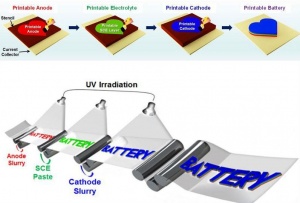Using a simple stencil printing process followed by ultraviolet cross-linking, researchers from the Ulsan National Institute of Science and Technology (UNIST, South Korea) have demonstrated a new type of Printable Solid-State (PRISS) Lithium-ion batteries designed through successive layers of curable composite materials.
Circumventing solvent-drying and liquid-electrolyte injection process steps, while removing the need for conventional microporous separator membranes, makes the printable batteries truly shape-conformable.
For more detail: Printable battery paves the way for custom-shape power sources
